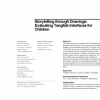Free Online Productivity Tools
i2Speak
i2Symbol
i2OCR
iTex2Img
iWeb2Print
iWeb2Shot
i2Type
iPdf2Split
iPdf2Merge
i2Bopomofo
i2Arabic
i2Style
i2Image
i2PDF
iLatex2Rtf
Sci2ools
CHI
2009
ACM
2009
ACM
Storytelling through drawings: evaluating tangible interfaces for children
This paper presents an ongoing study comparing the potential and the quality of the experiences provided by tangible versus traditional interfaces. The study was carried with two groups of kindergarten children using two interfaces that aim to motivate children to the practice of oral hygiene. Childrens drawings were one of the methods used to assess their experience. We found differences quantitatively and qualitatively between the drawings of the children interacting with the tangible interface and the traditional interface. The drawings suggest that by interacting with the tangible interface children felt more actively involved with the task. Keywords Tangible Interfaces, Drawing, Children, Evaluation. ACM Classification Keywords H5. 2. User Interfaces: Evaluation / Methodology
CHI 2009 | Human Computer Interaction | Keywords Tangible Interfaces | Tangible Interface Children | Versus Traditional Interfaces |
| Added | 24 Nov 2009 |
| Updated | 24 Nov 2009 |
| Type | Conference |
| Year | 2009 |
| Where | CHI |
| Authors | Cristina Sylla, Pedro Branco, Clara Coutinho, Maria Eduarda Coquet |
Comments (0)

